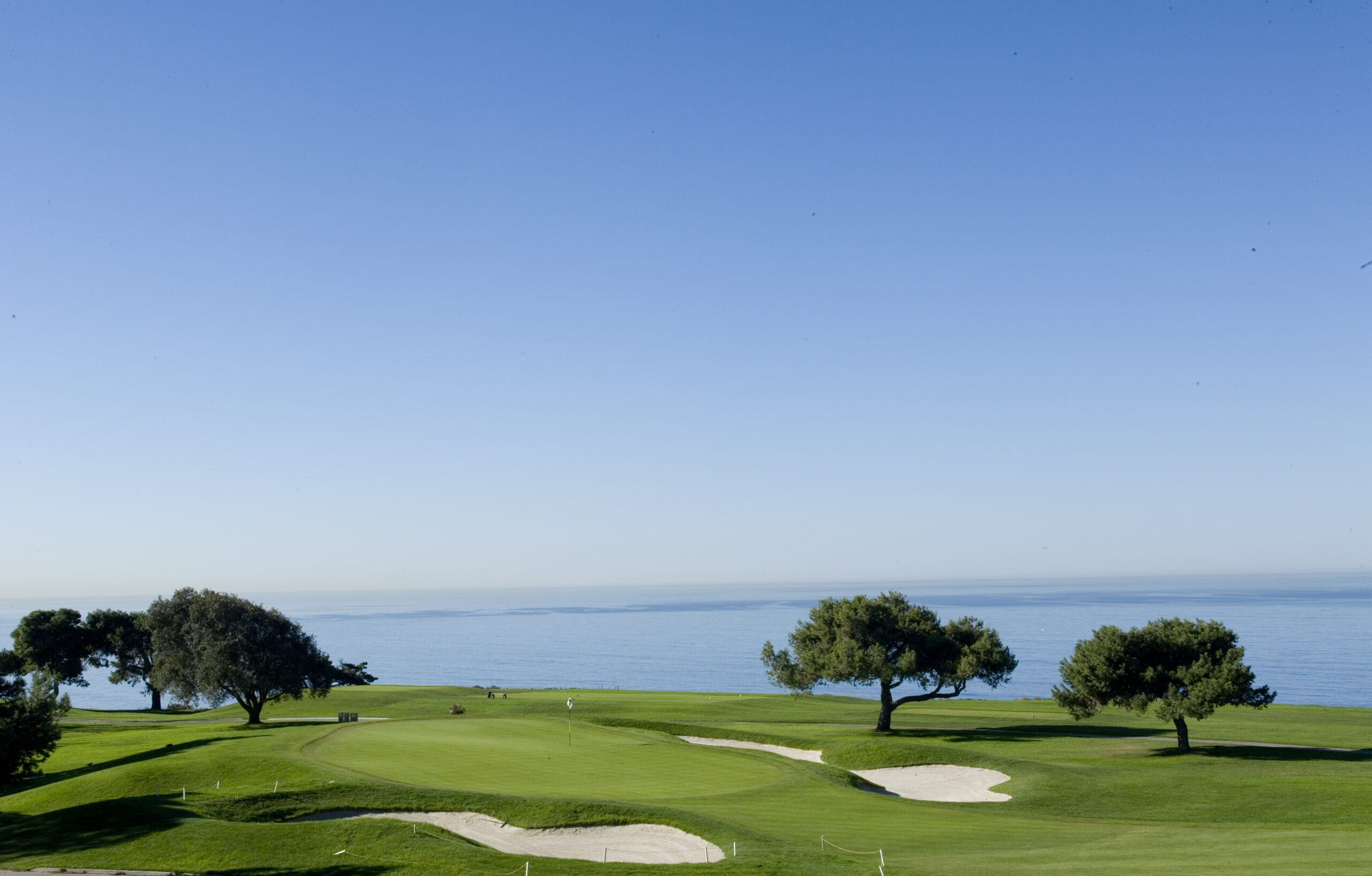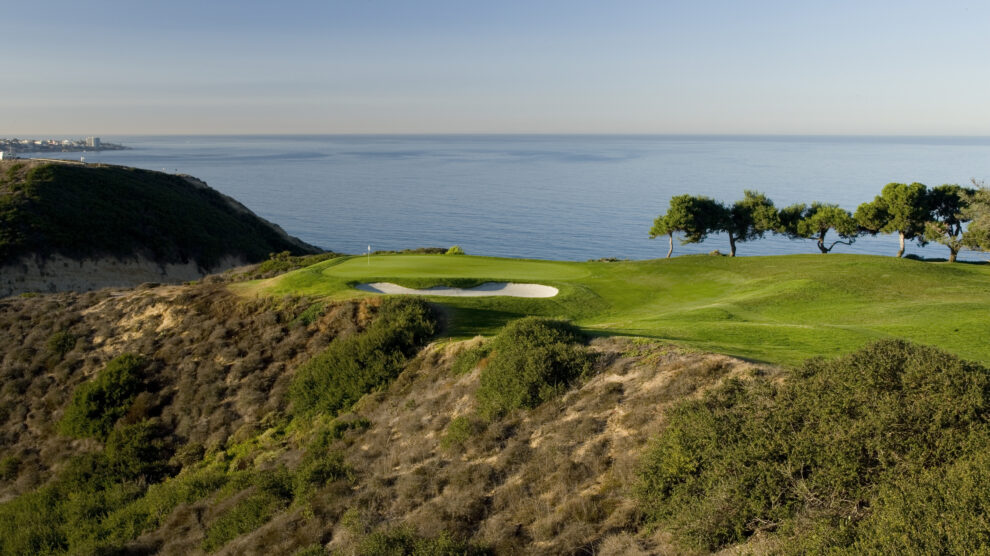The image of Tiger Woods releasing a jubilant scream toward the sky—his back arched and two fists pumping—just after his 12-foot birdie putt curled into the cup on the 18th hole of Torrey Pines’ South Course is iconic. It’s a scene that will forever be etched into the minds of golf fans who watched that epic U.S. Open in 2008. It’s a moment that has decisively linked San Diego with championship golf ever since; and each year around this time that link grows temporarily stronger as the PGA Tour makes its annual visit to San Diego for the Farmers Insurance Open.
However, championship golf in the greater San Diego area isn’t reserved just to the 192 acres that encompass the North and South Courses at Torrey Pines. It also extends 13 miles north to Carlsbad, where two sprawling resorts feature premier layouts with impressive résumés of past, present, and soon-to-be future professional championships of the highest caliber.

History Resurrected: La Costa Resort
Originally designed and built by Dick Wilson in 1965, La Costa’s foundational golf course was an expensive venture for its time. The 7,200-yard layout covered 215 acres and carried a $1.5 million price tag -- a cost equivalent to almost $14 million today. It was a justified investment, however, since La Costa had been chosen as the host course for the nationally televised CBS Golf Classic, an exhibition event that attracted the game’s elite players of that era -- names such as Snead, Floyd, Palmer and Nicklaus.
Shortly thereafter, La Costa welcomed the PGA Tour’s Tournament of Champions -- an exclusive, invitational event that was contested at the resort for three decades, beginning in 1969. The parade of all-time great players who walked La Costa’s fairways over that time included many of the aforementioned golfers, as well as Hall of Famers Gary Player, Lee Trevino, Johnny Miller and Tom Watson.
More than two decades after the Tournament of Champions relocated to its present site at Kapalua Resort, the aptly named Champions Course at La Costa had grown tired. Although numerous restoration and renovation efforts had been conducted over the years, the most recent attempts hadn’t aged well, which is why the resort has tasked Gil Hanse and Jim Wagner with the enterprise of transforming the layout into a venue fit to host the NCAA Division I Women’s and Men’s Golf Championships, which will be contested there for three consecutive years beginning in 2024.
The Hanse Golf Course Design team recently broke ground at the resort, and across the next several months it will tweak every hole on the course -- some more significantly than others. The eighth, ninth and 10th holes, for example, are all set to change dramatically. In their current state, each hole is accentuated by man-made water hazards, but when Hanse’s work is complete, this trio of holes will meander over and around a series of dry washes and barrancas -- features that will not only make these holes more playable for resort guests (i.e. average golfers with mid to high handicaps) but will also infuse the course with a more authentic sense of place.
“Dare I say those holes feel a bit more like they belong in Florida at the moment,” Hanse says, referencing the sizeable lagoons that delineate the edges of the playing areas. “But the setting and surrounds of the Champions Course lend themselves to a golf experience that looks and feels authentic to Southern California. I’m hopeful that when we’re done we’ll create holes that you’ve never seen before and in a landscape that’s distinctive enough so that people will really appreciate those changes.”
In particular, Hanse plans to shift the tee boxes notably to the left on the par-3 eighth, reducing it to a short, one-shot hole that plays no more than 150 yards. At the same time, he and his team will rebuild the small plateau green -- one that early on in the process Hanse nicknamed “Little Terror” -- adding a steep slope that will funnel errant shots toward the barranca on the right and positioning bunkers in front, on the left and behind the putting surface.
The par 3’s diminutive size will make it less intimidating to average players, but challenging hole locations, ones requiring absolute precision, will test the best players in collegiate golf.
“One of the things about those types of holes,” Hanse says of short par 3s, “good players can’t help but be aggressive. They’re always going to attack a flagstick when they have a 9-iron or a wedge in their hands. And if the consequences are severe should they fail, that makes for a compelling golf hole.”
Relocating the green on that eighth hole will also allow Hanse to lengthen the par-4 ninth, and those two modifications -- shortening a par 3 and lengthening a par 4 -- will, in Hanse’s opinion, fill two voids that currently prevent the course from feeling fully composed.
“Any great golf course has a variety of holes,” he says, “and that’s the thing that we’re always striving for.”
The other objective is to create a course that can be a stout test for championship events but still be approachable and enjoyable for the everyday player. As Hanse explains, they’ll look to achieve that by building wide playing corridors where proper positioning is required to open up opportunistic angles into greens. In that way, Hanse believes that the amount of precision needed to play the golf course will be low, but the level of precision to score well will be high.
Beyond the immediate task at hand, which includes creating a resort amenity that can transform into a compelling championship venue, Hanse is most excited about the prospect of furthering the site’s legacy as a stage for world-class golf.
“Growing up on the East Coast and watching the tournaments here and seeing the best players in the world play here, that resonates with me,” Hanse says. “The magnitude and significance of that is not lost on Jim [Wagner] or myself; and if we do our job, that history is going to be resurrected. We’ll see future LPGA and PGA players pass through here. That makes me happy—to play a part in reconnecting this course to a significant place in the golf world.”

Beauty and the Beast: Aviara Golf Club
Barely a mile to the west, the Aviara Golf Club is home to the only Arnold Palmer-designed course in San Diego County, one that hosted an annual LPGA event for the better part of a decade. Such championship pedigree only adds to the golf club’s already strong allure. As Renny Brown, Aviara’s director of golf declares: “Having Arnold Palmer as your golf course architect, and having his name associated with your event, is never a bad thing.”
Nestled into a trio of valleys and meandering across 180 acres, the 7,007-yard layout debuted in 1991, but it required about a decade of work before it opened for play, mostly due to strict environmental concerns and several protected wildlife areas that had to be preserved. When all was said and done, the resulting course rambled over rolling terrain, delivering about 500 feet of total elevation change. And as Brown acknowledges, the course hasn’t changed much in that time, aside from the fact that many of the trees lining the playing corridors have now reached their full maturity.
If you’re familiar with Palmer’s work as a course designer, you’re certain to spot characteristics that reflect The King’s architectural style. Most notably, Aviara is defined by wide, generous landing areas, large bunkers, equally large greens and gradual undulations across the terrain.
“Even if you’ve never played here before you can feel comfortable off the tee,” Brown says, “because what you see is what you get. Definitely spend some time on the putting green, though, because the greens here are the challenge.”
Yes, Aviara features several prominent water hazards that are in play on half of the holes, and those penal areas are certain to affect that average golfer; however, it’s the green complexes—and significantly contoured putting surfaces, specifically—that make the golf course an ideal venue for championship golf.
“The greens are the defense of the golf course for the better player,” says Brown. “They’re very large with a lot of slope and undulation. It’s about more than just hitting it on the green. [To score], it’s about hitting it in the right spot.”
Because of the aforementioned natural wetlands and the nearby Batiquitos Lagoon Nature Preserve, which the course overlooks, Aviara is surrounded by an abundance of flora that is in bloom for much of the year. For that reason, a round here has often been described as “golf within a botanical garden.” In Brown’s estimation, that natural beauty is another attribute that makes Aviara an ideal tour venue, since the course always shows exceptionally well on TV.
As for the most beautiful of Aviara’s 18 holes, the club’s director of golf points to number 14, a downhill par three that plays 200 yards from the back tees to a green fronted by water and framed by a hillside of flowering trees and bushes. “She’s the show pony,” he says. “But we probably have at least five holes that any golf course in America would consider to be their signature hole.”
All of this is to say that first-time visitors shouldn’t underestimate Aviara Golf Club, even though it technically qualifies as a resort course.
“That’s almost a negative term at times,” Brown says of the ‘resort’ designation, “but we’re an atypical resort course. From the back tees, it can certainly be a challenge, even for really good golfers.”

Transformative Measures: The Tale of Torrey Pines
“You don’t build a church for Easter Sunday,” declares Rees Jones, the architect who boldly renovated -- some might say redesigned -- Torrey Pines ahead of its successful bid to host the U.S. Open in 2008.
In other words, when he took on the course transformation project back in early 2000s, Jones knew that he couldn’t reconstruct the municipal golf club’s South Course into a layout that could only be successfully played by the world’s best golfers. Yes, the course would occasionally host the country’s most prestigious major championship -- and one week a year the PGA Tour would descend on San Diego for the Farmers Insurance Open that’s played at Torrey Pines -- but, as the 81-year-old acknowledges: “The other 51 weeks out of the year the golf course has to accommodate a different level of player.”
Much of the heavy lifting that was required to transform the now-65-year-old South Course into a true, major championship venue occurred in 2001. Greens were rebuilt, re-contoured and relocated closer to several canyons that weave their way through the site; fairway bunkers were re-positioned to challenge today’s long-hitting players; and the course was lengthened by more than 500 yards from the championship tees.
“We changed the strategy of the course,” Jones says.
In 2019, Jones returned to update the course, which had logged more than 1 million rounds since the completion of the architect’s first overhaul. This time around, large-scale infrastructure improvements were made, including the installation of a new irrigation system. Additionally, sand bunkers were rebuilt, some were relocated, some were reshaped and others were eliminated to improve the quality of play for everyday players, not to mention to speed up the pace of play. On that last topic, more forward tees were added to a third of the holes, while select sets of “intermediate” tees were relocated or expanded to improve playability.
A handful of holes also benefited from the creation of tightly mowed chipping areas around the greens (which offer lesser-skilled players more recovery options), while all holes were enhanced by the implementation of new turf in the areas approaching the greens.
“It was like Heinz 57,” Jones says of the mixture of grass varietals that previously made up those approach areas 15 yards or so short of the putting surfaces.
Now, they feature Latitude 36 bermudagrass, a species that is finer in texture and more resilient to colder temperatures.
All of those aforementioned turf improvements or additions around the greens reflect Jones’ upbringing in the northeast, where he was exposed to the classic course designs of A.W. Tillinghast, an architect who would often create a green complex where a section of the putting surface was guarded by a bunker or a hazard but other areas were open and accessible.
“The ground game was in vogue when he was designing,” Jones explains. “Just watching the shot options that he utilized, that taught me. That’s what made me realize that you had to design for everyone’s abilities.”
The South Course’s greens, which cover an average area of about 6,000 square feet, are boldly contoured and were shaped in such a way that many can feature challenging hole locations. “The greens are what make any championship course these days because the pros are hitting the ball so far,” Jones opines. “At Torrey, we built diagonal greens and we designed a lot of greens with little tongues—places where greenkeepers can hide pins behind contours or in corners.”
For that reason, Jones advises many first-time players to take stock of a hole’s pin placement and to adhere to a conservative strategy with their approach shots. “The average golfer has to not always go for the pin if it’s hid by a contour or a bunker or an angle,” he says. “They need to play to the center of the green.”
At times, those players would also do well to remember that the course was designed for players of all ability levels, which means they can play higher-percentage shots that bounce and roll up onto the greens. They won’t always need to attack a green from the air, even if those are the shots that they’ll see the world’s best players hit during PGA Tour broadcasts.
“On a number of holes, they can access the green on the ground,” Jones reminds average players. “The pros don’t do that.”

